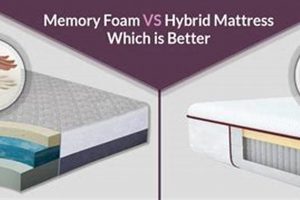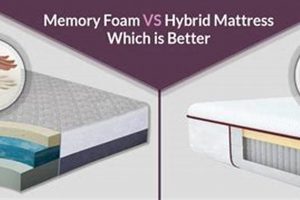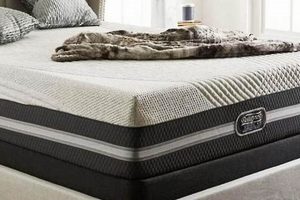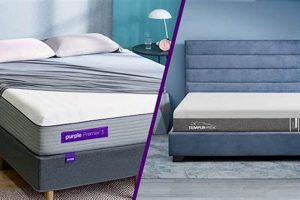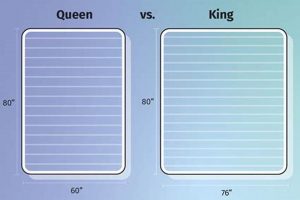A comparison of two popular mattress brands, Nectar and DreamCloud, involves evaluating their distinct construction, materials, and overall performance characteristics. This allows consumers to make an informed decision based on their individual sleep preferences and needs. This assessment typically considers factors such as firmness level, support, cooling capabilities, motion isolation, and edge support.
The relevance of evaluating these mattresses stems from the significant impact a mattress has on sleep quality and overall well-being. A supportive and comfortable mattress can contribute to reduced back pain, improved sleep posture, and increased restfulness. Understanding the nuances of each brand’s offerings enables consumers to prioritize their specific sleep needs and invest in a mattress that promotes optimal sleep health.
The following sections will delve into the specifics of each mattress brand, examining their construction, features, and performance characteristics in detail. This will provide a comprehensive overview to assist consumers in determining which mattress best aligns with their individual requirements.
Comparative Considerations for Nectar and DreamCloud Mattresses
The selection of a mattress represents a significant investment in personal health and well-being. When evaluating Nectar and DreamCloud options, several factors merit careful consideration.
Tip 1: Assess Firmness Preferences: Nectar mattresses generally offer a medium-firm feel, suitable for a wide range of sleepers. DreamCloud models often present a slightly firmer profile. Evaluate personal comfort preferences to determine which firmness level provides optimal support and pressure relief.
Tip 2: Examine Construction Materials: Nectar typically utilizes memory foam as a primary comfort layer, offering body contouring. DreamCloud often incorporates a hybrid design, combining memory foam with innerspring coils. Understanding the properties of each material is crucial for predicting overall performance and durability.
Tip 3: Investigate Temperature Regulation: Memory foam can sometimes retain heat. Evaluate the cooling technologies employed by each brand, such as gel-infused foam or breathable covers, to mitigate potential heat buildup during sleep.
Tip 4: Evaluate Motion Isolation: Couples should prioritize motion isolation to minimize sleep disturbances caused by partner movement. Memory foam generally excels in this area. Assess independent testing results to compare motion isolation capabilities objectively.
Tip 5: Consider Edge Support: Strong edge support allows sleepers to utilize the entire mattress surface and provides stability when sitting on the edge. Innerspring hybrid mattresses often exhibit superior edge support compared to all-foam models.
Tip 6: Scrutinize Warranty and Trial Period: A comprehensive warranty and a generous trial period provide assurance and allow consumers to thoroughly evaluate the mattress in their own homes. Review the terms and conditions of each offering carefully.
Tip 7: Analyze Budgetary Constraints: Nectar and DreamCloud mattresses typically occupy different price points. Establish a realistic budget and prioritize the features that align with individual needs and preferences to make a financially sound decision.
Careful consideration of these elements contributes to a more informed decision when selecting between Nectar and DreamCloud mattresses. Understanding personal needs and comparing the specific attributes of each model maximizes the likelihood of a satisfactory purchase.
The following section will provide a detailed conclusion, summarizing the key distinctions and offering final recommendations based on varying sleep profiles.
1. Firmness
Firmness represents a critical differentiator in the “nectar mattress vs dreamcloud” comparison. The firmness level of a mattress directly influences spinal alignment, pressure relief, and overall sleep comfort. Mattresses perceived as too soft may lack adequate support, leading to spinal misalignment and potential back pain. Conversely, overly firm mattresses can create pressure points, disrupting sleep and causing discomfort. The ideal firmness is subjective and depends on factors such as sleeping position, body weight, and personal preference.
Nectar mattresses are generally characterized by a medium-firm feel, often rated around a 6 out of 10 on a firmness scale where 1 is very soft and 10 is very firm. This firmness level aims to accommodate a wide range of sleepers, providing a balance between support and contouring. DreamCloud mattresses, particularly the original DreamCloud, tend to present a slightly firmer profile, often rated around a 6.5 to 7. This increased firmness is largely attributed to the inclusion of innerspring coils in their hybrid construction, which offers enhanced support and responsiveness. For instance, individuals who primarily sleep on their back or stomach may find the firmer support of a DreamCloud mattress more suitable for maintaining proper spinal alignment. Side sleepers, however, may prefer the more conforming feel of a Nectar mattress to alleviate pressure on their shoulders and hips.
Understanding the firmness variations between Nectar and DreamCloud is essential for selecting a mattress that promotes optimal sleep health. The practical significance of this understanding lies in mitigating potential discomfort and ensuring a restful sleep experience. Choosing a mattress with an inappropriate firmness level can lead to chronic pain and sleep deprivation. Therefore, carefully considering personal preferences and sleep habits is crucial when evaluating the firmness characteristics of these two mattress brands. This allows for a more informed purchasing decision, resulting in improved sleep quality and overall well-being.
2. Materials
Material composition significantly differentiates Nectar and DreamCloud mattresses, directly influencing factors such as comfort, support, durability, and temperature regulation. A thorough understanding of these materials is essential for informed consumer choice.
- Foam Density and Type
Nectar mattresses primarily utilize various densities of memory foam, influencing overall feel and contouring. Higher density foams tend to offer greater support and durability but may also retain more heat. DreamCloud employs a hybrid construction, combining memory foam layers with an innerspring coil system. The type and density of foam layers in both brands contribute to pressure relief and motion isolation capabilities. For example, a higher density memory foam may provide enhanced support for heavier individuals. The long-term performance of a mattress is substantially influenced by the quality and density of the foams used.
- Coil System (DreamCloud)
DreamCloud mattresses incorporate a pocketed coil system, where individual coils are wrapped in fabric. This design minimizes motion transfer and provides targeted support. The gauge (thickness) and count of the coils contribute to the overall firmness and support of the mattress. A higher coil count generally indicates greater conformity and reduced motion transfer. The coil system directly affects the responsiveness and bounce of the mattress, differing significantly from the all-foam construction of Nectar mattresses.
- Cover Fabric
The mattress cover serves as the first point of contact and plays a crucial role in breathability and temperature regulation. Nectar and DreamCloud utilize different cover fabrics, often incorporating materials like Tencel or other breathable textiles. These materials aim to wick away moisture and promote airflow, preventing heat buildup during sleep. The texture and feel of the cover also contribute to the overall comfort experience. Some covers may also be removable and washable, enhancing hygiene and extending the lifespan of the mattress.
- Adhesives and Fire Retardants
Adhesives are used to bond different layers of the mattress together, while fire retardants are essential for safety compliance. The type and composition of these materials can impact air quality and potential off-gassing. Certifications such as CertiPUR-US indicate that the foams used in the mattress have been tested for harmful chemicals and low VOC emissions. Consumers concerned about potential allergens or sensitivities should research the specific adhesives and fire retardants used in each mattress.
In summary, the choice between Nectar and DreamCloud involves a careful consideration of their respective material compositions. Nectar’s all-foam construction emphasizes conforming comfort, while DreamCloud’s hybrid design prioritizes support and responsiveness. Examining the specific types and qualities of the foams, coils, cover fabrics, and other materials allows consumers to make an informed decision based on their individual needs and preferences. For example, if the consumer values the breathability of the natural cotton used in Nectar, that is an option as well.
3. Support
Support, in the context of the “nectar mattress vs dreamcloud” comparison, refers to the mattress’s ability to maintain proper spinal alignment and distribute body weight evenly. Adequate support prevents sinking or sagging, reducing pressure points and promoting a comfortable and restful sleep experience. The level of support provided by a mattress directly influences its suitability for different sleeping positions and body types.
- Spinal Alignment
Maintaining proper spinal alignment is paramount for long-term musculoskeletal health. A mattress that fails to adequately support the spine can lead to chronic back pain and discomfort. “Nectar mattress vs dreamcloud” both strive to provide adequate support, but their approaches differ. Nectar’s memory foam construction aims to contour to the body’s natural curves, while DreamCloud’s hybrid design incorporates innerspring coils for enhanced support. For example, a side sleeper may require a mattress that allows the shoulders and hips to sink in slightly, while a back sleeper needs firmer support to prevent the spine from curving excessively.
- Weight Distribution
Effective weight distribution prevents localized pressure points and ensures that no single area of the body bears excessive weight. Mattresses that distribute weight evenly promote circulation and reduce the likelihood of tossing and turning during the night. In the “nectar mattress vs dreamcloud” comparison, the materials used in each mattress contribute to their respective weight distribution capabilities. Memory foam is known for its ability to conform to the body’s shape, while innerspring coils provide a more uniform and responsive support surface. For instance, a heavier individual may benefit from the enhanced support of a DreamCloud mattress, which can prevent excessive sinking and maintain spinal alignment.
- Edge Support
Edge support refers to the firmness and stability of the mattress edges. Strong edge support allows sleepers to utilize the entire surface of the mattress and provides stability when sitting on the edge. In the “nectar mattress vs dreamcloud” analysis, edge support can vary. Hybrid mattresses, like DreamCloud, often exhibit superior edge support due to the presence of reinforced coils along the perimeter. All-foam mattresses, like Nectar, may exhibit some compression along the edges, particularly with prolonged use. Adequate edge support is particularly important for individuals who share a bed or those who tend to sleep near the edge of the mattress.
- Long-Term Durability
Long-term durability directly relates to how well a mattress maintains its support characteristics over time. A mattress that initially provides adequate support may degrade over time, leading to sagging and reduced comfort. “Nectar mattress vs dreamcloud” should be evaluated not only on initial comfort and support but also on their projected lifespan and resistance to wear and tear. Factors such as foam density, coil gauge, and overall construction quality contribute to the long-term durability of a mattress. For example, a mattress with high-density foam and a robust coil system is likely to maintain its support capabilities for a longer period than a mattress with lower-quality materials.
In conclusion, support plays a vital role in the “nectar mattress vs dreamcloud” evaluation. The ability to maintain proper spinal alignment, distribute weight evenly, provide adequate edge support, and withstand long-term use are all critical factors to consider when choosing a mattress. By understanding the specific support characteristics of each brand, consumers can make an informed decision that promotes optimal sleep health and overall well-being.
4. Cooling
Temperature regulation during sleep significantly impacts overall sleep quality. Mattresses that retain heat can disrupt sleep cycles, leading to discomfort and restlessness. Consequently, cooling technologies and materials represent a crucial consideration when evaluating Nectar and DreamCloud mattresses. The effectiveness of a mattress in dissipating heat directly affects its suitability for individuals prone to sleeping hot.
- Gel-Infused Memory Foam
Gel-infused memory foam is a common cooling technology employed in both Nectar and DreamCloud mattresses. Gel particles are incorporated into the memory foam structure to absorb and dissipate heat, reducing temperature buildup. The effectiveness of gel infusion varies depending on the concentration and type of gel used. For instance, some gel infusions may provide only minimal cooling benefits, while others offer more noticeable temperature regulation. Independent testing and user reviews can provide insights into the actual cooling performance of gel-infused memory foam in Nectar and DreamCloud mattresses.
- Breathable Cover Fabrics
The mattress cover plays a crucial role in promoting airflow and wicking away moisture. Nectar and DreamCloud utilize various breathable cover fabrics, such as Tencel or cotton blends, to enhance temperature regulation. These materials allow air to circulate freely, preventing heat from becoming trapped between the sleeper and the mattress surface. The weave and thickness of the cover fabric also influence its breathability. For example, a looser weave may provide better airflow than a tightly woven fabric. The design of a mattress cover can either reduce, or exacerbate heat issues in the user
- Coil Systems and Airflow
DreamCloud mattresses, with their hybrid construction incorporating innerspring coils, generally offer enhanced airflow compared to all-foam mattresses like Nectar. The spaces between the coils allow for greater air circulation, dissipating heat more effectively. This design feature can be particularly beneficial for individuals who tend to sleep hot. The coil system provides a natural pathway for heat to escape, preventing it from being trapped within the mattress layers. This advantage in airflow contributes to a cooler and more comfortable sleep environment.
- Phase Change Materials (PCMs)
Phase change materials (PCMs) represent a more advanced cooling technology that may be incorporated into some Nectar or DreamCloud models. PCMs absorb and release heat as they transition between solid and liquid states, providing a more dynamic and responsive cooling effect. These materials can help to regulate temperature fluctuations throughout the night, maintaining a consistent and comfortable sleep surface. The effectiveness of PCMs depends on the specific type and concentration used. PCMs can act as a crucial feature for people who sleep hot and are looking for a mattress.
In the Nectar and DreamCloud comparison, cooling capabilities represent a significant factor for consideration, especially for individuals sensitive to temperature during sleep. The effectiveness of gel-infused memory foam, breathable cover fabrics, coil systems, and phase change materials can all contribute to a cooler and more comfortable sleep experience. Evaluating the specific cooling technologies employed in each mattress, coupled with user reviews and independent testing data, allows consumers to make an informed decision based on their individual temperature preferences and needs. For example, certain cooling systems that promote airflow can even stop night sweats, a prevalent issue for people going through menopause.
5. Motion Isolation
Motion isolation, in the context of mattress performance, quantifies the degree to which movement on one side of the bed is transferred to the other. This is a particularly salient consideration for couples or individuals sharing a sleep surface. The effectiveness of motion isolation directly impacts sleep quality by minimizing disturbances caused by a partner’s movements, such as getting in or out of bed, or simply tossing and turning during the night. The “nectar mattress vs dreamcloud” comparison necessitates a careful evaluation of motion isolation capabilities, given the differing construction materials and designs of these mattresses.
All-foam mattresses, like the Nectar, generally excel in motion isolation due to the inherent damping properties of memory foam. The dense structure of memory foam absorbs and dissipates motion energy, preventing it from propagating across the mattress surface. In contrast, hybrid mattresses, such as the DreamCloud, which incorporate innerspring coils, may exhibit less effective motion isolation. While individually pocketed coils aim to minimize motion transfer, some degree of movement may still be felt due to the interconnected nature of the coil system. The practical significance of this difference is evident in real-world scenarios. For instance, a light sleeper sharing a bed with a restless partner may experience fewer sleep disruptions on a Nectar mattress compared to a DreamCloud mattress, assuming all other factors are equal. Conversely, a heavier sleeper might prioritize the enhanced support of the DreamCloud, even if it comes at the expense of slightly reduced motion isolation.
Ultimately, the ideal choice between “nectar mattress vs dreamcloud” with respect to motion isolation depends on individual sleep preferences and sensitivities. Couples who are particularly sensitive to movement should prioritize mattresses with superior motion isolation capabilities, such as the Nectar. However, the benefits of enhanced support and breathability offered by the DreamCloud may outweigh the slightly reduced motion isolation for some individuals. Quantifiable metrics, such as independent testing results that measure motion transfer, provide objective data to inform this decision-making process. Addressing this concern allows individuals to choose a model that facilitates restorative sleep, despite shared bed space or partner activity.
6. Price
Price constitutes a pivotal determinant in the comparative analysis of Nectar and DreamCloud mattresses. The financial investment required represents a significant consideration for prospective buyers, influencing their ultimate decision based on budgetary constraints and perceived value.
- Initial Purchase Cost
The upfront cost of a mattress serves as the primary financial barrier for consumers. Nectar mattresses generally occupy a more accessible price point compared to DreamCloud models. This difference is largely attributable to the all-foam construction of Nectar, which typically involves less expensive materials and manufacturing processes than DreamCloud’s hybrid design. This initial price disparity impacts consumer accessibility, potentially favoring Nectar for budget-conscious shoppers. However, the long-term value proposition requires further consideration, as durability and performance influence the overall cost-effectiveness.
- Financing Options and Payment Plans
Many mattress companies offer financing options and payment plans to mitigate the financial burden of a significant purchase. The availability and terms of these financing programs can vary between Nectar and DreamCloud, influencing the overall affordability for consumers. For example, promotional periods with reduced or zero-interest financing can significantly impact the perceived cost. Evaluating the specific financing terms, including interest rates and repayment schedules, is essential for making an informed financial decision.
- Promotions and Discounts
The mattress industry frequently employs promotional strategies, including discounts, bundled offers, and seasonal sales. These promotions can significantly alter the effective price of Nectar and DreamCloud mattresses. Comparing the frequency and magnitude of these promotions is crucial for identifying the most cost-effective purchasing opportunity. For instance, holiday sales or limited-time discounts may offer substantial savings, narrowing the price gap between the two brands. Actively monitoring promotional campaigns allows consumers to maximize their purchasing power.
- Long-Term Value and Durability
While initial purchase price is a primary consideration, the long-term value and durability of a mattress influence its overall cost-effectiveness. A less expensive mattress that degrades rapidly or requires premature replacement may ultimately prove more costly than a more durable, albeit pricier, option. Evaluating the expected lifespan, warranty terms, and user reviews pertaining to durability is essential for assessing the long-term value of Nectar and DreamCloud mattresses. A longer lifespan amortizes the initial cost over a greater period, potentially justifying a higher upfront investment.
In conclusion, price represents a multifaceted consideration in the Nectar and DreamCloud comparison. Evaluating the initial purchase cost, financing options, promotional opportunities, and long-term value is essential for making a financially sound decision. Consumers must weigh their budgetary constraints against their individual sleep needs and preferences to determine the most cost-effective mattress solution. Prioritizing both affordability and long-term performance ensures a satisfactory investment in sleep health.
Frequently Asked Questions
This section addresses commonly asked questions regarding the comparison between Nectar and DreamCloud mattresses, providing clarity on key distinctions and performance characteristics.
Question 1: What are the primary differences in construction between Nectar and DreamCloud mattresses?
Nectar mattresses primarily employ an all-foam construction, typically utilizing multiple layers of memory foam. DreamCloud mattresses feature a hybrid design, combining layers of memory foam with an innerspring coil system. This fundamental difference in construction influences factors such as support, motion isolation, and temperature regulation.
Question 2: How do the firmness levels of Nectar and DreamCloud mattresses compare?
Nectar mattresses generally exhibit a medium-firm feel, catering to a broad range of sleepers. DreamCloud mattresses tend to present a slightly firmer profile, often attributable to the presence of innerspring coils. Individual perceptions of firmness can vary based on body weight and sleep preferences.
Question 3: Which mattress is better suited for individuals who sleep hot?
DreamCloud mattresses, with their hybrid design, often offer enhanced airflow compared to Nectar’s all-foam construction. The spaces between the coils facilitate heat dissipation. Both brands may incorporate cooling technologies such as gel-infused memory foam or breathable cover fabrics to mitigate heat retention.
Question 4: How do Nectar and DreamCloud mattresses compare in terms of motion isolation?
Nectar mattresses, due to their all-foam construction, typically excel in motion isolation. Memory foam effectively absorbs and minimizes motion transfer. DreamCloud mattresses, while utilizing individually pocketed coils, may exhibit less effective motion isolation compared to all-foam models.
Question 5: What are the typical price points for Nectar and DreamCloud mattresses?
Nectar mattresses generally occupy a more accessible price point compared to DreamCloud mattresses. This difference reflects the variations in materials and construction complexity. Promotional periods and discounts can influence the effective price of both brands.
Question 6: What warranty and trial period options are offered by Nectar and DreamCloud?
Both Nectar and DreamCloud typically offer generous warranty and trial period options. Consumers should review the specific terms and conditions of each offering, including the duration of the warranty and the requirements for returns.
In summary, the choice between Nectar and DreamCloud mattresses hinges on individual preferences and priorities. Factors such as construction, firmness, cooling capabilities, motion isolation, price, and warranty terms should be carefully considered.
The following section will provide a final summary, offering a concluding perspective on the Nectar vs. DreamCloud mattress debate.
Nectar Mattress vs DreamCloud
The preceding analysis of “nectar mattress vs dreamcloud” has illuminated critical distinctions between these two prominent mattress brands. Nectar’s all-foam construction emphasizes conforming comfort and motion isolation, often at a more accessible price point. DreamCloud’s hybrid design prioritizes support, breathability, and a slightly firmer feel. Considerations such as firmness preference, temperature regulation needs, sensitivity to motion transfer, and budgetary constraints ultimately dictate the optimal choice. This careful examination provides consumers with essential information to facilitate a well-informed purchase decision.
The selection of a mattress profoundly impacts sleep quality and overall well-being. Therefore, a comprehensive evaluation, incorporating both objective data and personal preferences, remains paramount. Further independent research and consultation with sleep professionals may further refine the selection process, ensuring an investment that contributes to restorative sleep and long-term health.


